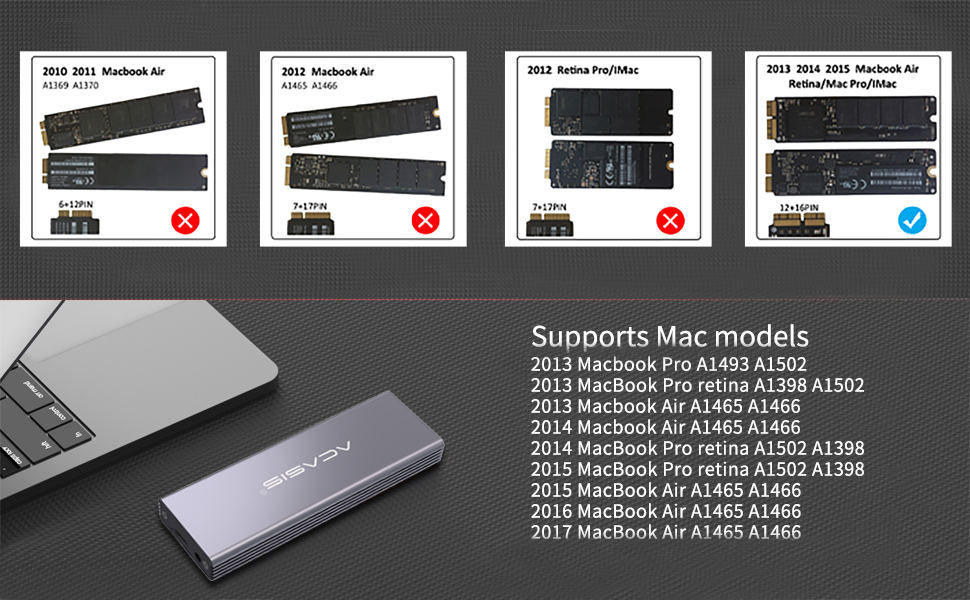
- #External ssd for mac 2014 install#
- #External ssd for mac 2014 upgrade#
- #External ssd for mac 2014 mac#
After that my initial use at the desktop was enough to make me think there was a hard drive issue.
#External ssd for mac 2014 mac#
I would click on the next button in the Mac setup (post-install, so it shouldn't have been on the usb) and it would spin for a solid 30 seconds to a minute before it went to the next screen. I have noticed that the installation and first 20 minutes of use of the computer were astonishingly slow. The lid close sleep problem appears resolved though. Came back with black screen and then eventually rebooted.

I drained the battery under heavy load to see how it would act when it ran out of battery life. I think that's roughly in line with my experience with the 128gb stock Apple drive. It lost 5% battery life overnight, and appears to lose about 6% or so an hour no hard drive activity but screen left on at 2/5ths max brightness. I left the computer unplugged and in sleep mode overnight for about 6 hours (which should have been time enough for 'deep sleep' or whatever that call it to kick in). I don't know if that's because they improved things in Mojave, or if it was a "stars aligning" kind of thing. The latter supposedly requires either disabling hibernation or using a chip writer and a firmware hack (!) and I think the former is just something you have to live with. According to other sources at MacRumors and StackExchange dated as recently as Aug 2018, there's supposedly an issue both with power management and sleep/wake with NVMe drives on 2014 MBPs.
#External ssd for mac 2014 install#
I followed through the install without any major glitches.

I believe that you have to have installed High Sierra on the Mac at least once for the new hard drive to even detect. After installation, I enabled trim via trimforce. I didn't need insulated tape for the connector. I needed the longer screw provided in the adapter kit.
#External ssd for mac 2014 upgrade#
My personal experience involved installing the new drive, having the web recovery fail, reinstalling the old drive, downloading the Mojave upgrade and following the usb bootable creation process, and then reinstalling the new drive and doing the Mojave install. Installation requires a little finesse, but ifixit covers the process well enough. Contrast to OWC drives currently running for 250 USD and the Transcend one running for 300 USD. I bought the Samsung 960 EVO 500GB to go with it. I have a 2014 MacBookPro11,1 (13 inch, Mid 2014) and I bought the NGFF M.2 PCIE adapter that Sintech makes for mine. The form factor is different but there's a Chinese company Sintech that makes various adapters to fix this issue. Read/write and boot-up work on 2013-2014 MBPs. Since the release of High Sierra there's been some support put in for NVMe drives. It's 2018 and I think the answer to this question has changed. Here's the direct Amazon Store that Transcend forwards you to in the link above. Most importantly, it looks like they offer a scan to confirm the proper upgrade for your specific model. (it's not out of stock, btw.) Except you get a couple extra goodies like an USB 3.0 enclosure for the drive you replace, tools, replacement guide, screws, rubber feet, etc. I recommend checking out Transcend's JetDrive since it's a comparable price to the ifixit link. Which means it's going to be more expensive off the bat since it's not in "high" demand and even more so since the seller probably knows it's intended for a MacBook. The only way to upgrade your MacBook (or more recent ones) is to buy an uncommon PCIe x2 SSD. That being said, a simple answer to your question is, no. We are talking about an Apple product though and it goes without saying that nothing is going to be standard or easy.

Many ultrabooks use this connection and you can easily buy adapters for regular laptops. MSATA's are incredibly universal and on par with the standard SSD pricing. The recent ones don't have the "easy" mSATA upgrade. I can personally confirm this info since I've worked on several dozen (retail returned) MacBooks over the past year and a half. This likely being the "easy upgrade" you mentioned. MacBook Pro's haven't had a standard mSATA connection since 2013.


 0 kommentar(er)
0 kommentar(er)
